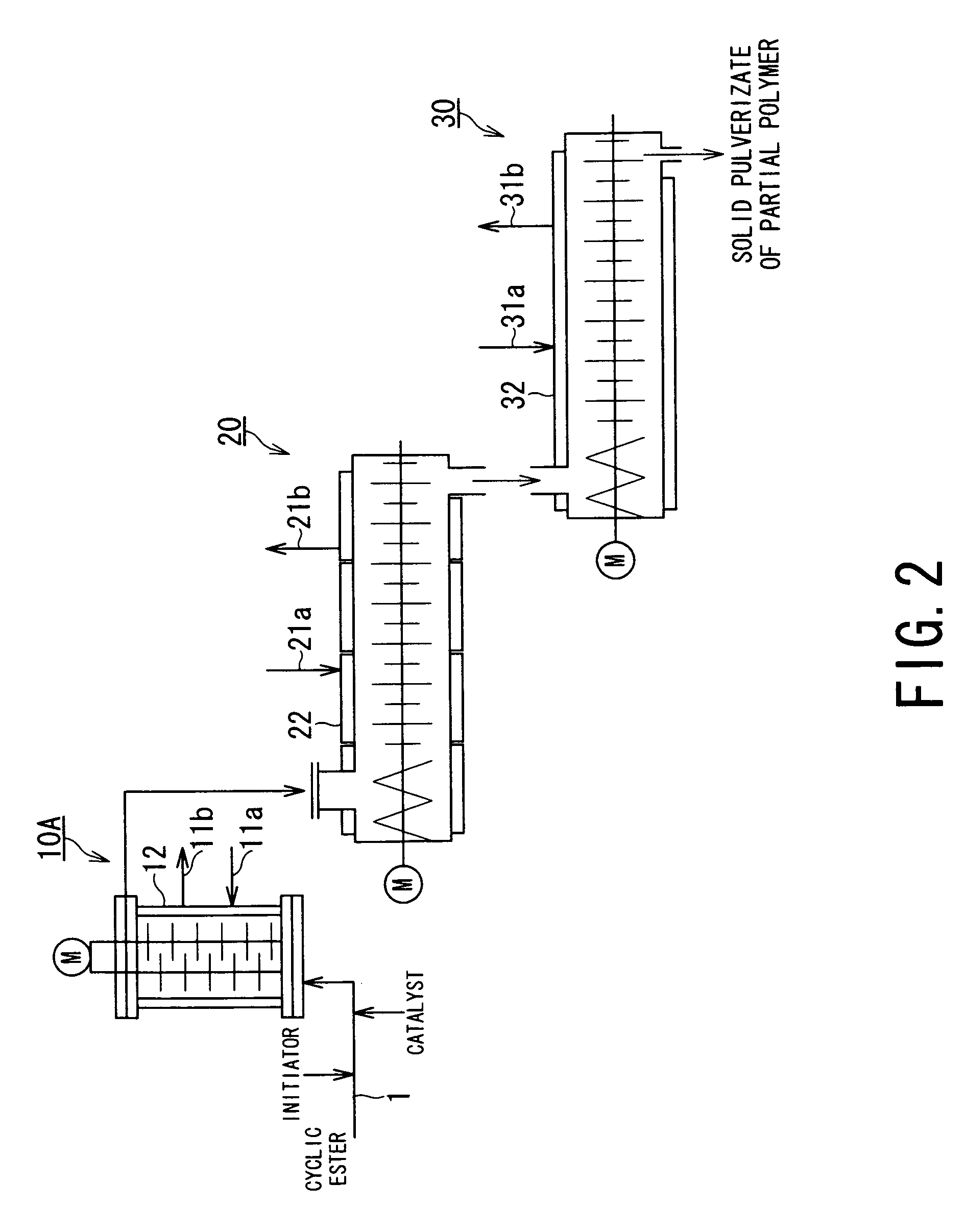Process for producing aliphatic polyester
a technology of aliphatic polyester and aliphatic polyester, which is applied in the direction of chemical/physical/physical-chemical processes, chemical apparatus and processes, chemical/physical/physical-chemical stationary reactors, etc., can solve the problems of difficult to obtain a high-molecular weight aliphatic polyester by poly-condensation of -hydroxy-carboxylic acid, and cannot be regarded as an entirely efficient process. , to achieve the effect of low discoloration
- Summary
- Abstract
- Description
- Claims
- Application Information
AI Technical Summary
Benefits of technology
Problems solved by technology
Method used
Image
Examples
example 1
[0082]Partial ring-opening polymerization of glycolide was performed by means of an apparatus system schematically shown in FIG. 1. More specifically, into a helical blade stirring vessel-type reactor (10) retaining nitrogen gas atmosphere and with a jacket temperature (TjI) set to 200° C., there were continuously charged a molten liquid of polymerization starting mixture comprising glycolide and 1-dodecanol at 0.2 mol % with respect to the glycolide at a rate of 3 kg / h and an ethyl acetate solution of tin dichloride as a catalyst (0.0015 g / ml) at rate of 1 ml / min. so as to be 30 ppm with respect to the glycolide.
[0083]Under continuation of the stirring, the polymerization starting mixture was continually charged, and at an average residence time of 5 min. in the reactor 10, the melt of reaction mixture at an internal temperature (TrI) of 180° C. was withdrawn from the reactor outlet at a rate of 3 kg / h and continuously charged to an equi-directionally rotating horizontal twin-screw...
example 2
[0092]Partial ring-opening polymerization of glycolide was performed by means of an apparatus system schematically shown in FIG. 2. More specifically, from a lower part of a liquid-filled stirring vessel-type reactor (10A) equipped with biaxial multi-stage paddle blades rotating in identical directions, retaining a nitrogen atmosphere and set to a jacket temperature (TjI) of 200° C., there were respectively continuously charged glycolide at a rate of 30 kg / h, 1-dodecanol (as an initiator) at a rate of 0.3 mol % of the glycolide and a 0.015 g / ml-solution in ethyl acetate of tin dichloride (as a catalyst) at a rate of 1 ml / min so as to be 30 ppm of the glycolide, through a glycolide feed pipe 1.
[0093]Under continuation of the stirring, the polymerization starting mixture was continually charged, and at an average residence time of 5 min, in the reactor 10, the melt of reaction mixture at an internal temperature (TrI) of 180° C. was withdrawn from the reactor outlet at a rate of 30 kg / ...
PUM
| Property | Measurement | Unit |
|---|---|---|
| boiling point | aaaaa | aaaaa |
| volume ratio | aaaaa | aaaaa |
| pressure | aaaaa | aaaaa |
Abstract
Description
Claims
Application Information
 Login to View More
Login to View More - R&D
- Intellectual Property
- Life Sciences
- Materials
- Tech Scout
- Unparalleled Data Quality
- Higher Quality Content
- 60% Fewer Hallucinations
Browse by: Latest US Patents, China's latest patents, Technical Efficacy Thesaurus, Application Domain, Technology Topic, Popular Technical Reports.
© 2025 PatSnap. All rights reserved.Legal|Privacy policy|Modern Slavery Act Transparency Statement|Sitemap|About US| Contact US: help@patsnap.com


